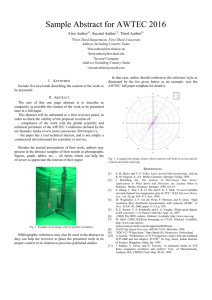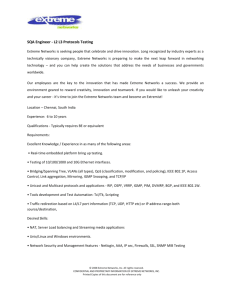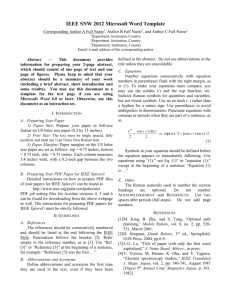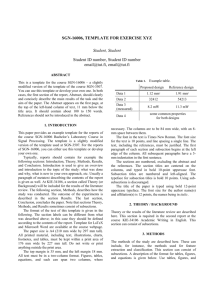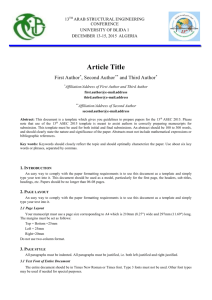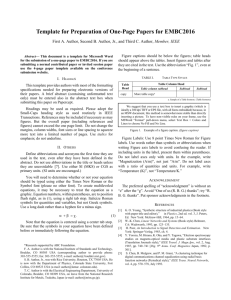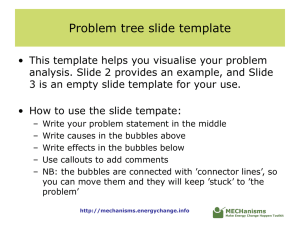MS Word - EMTS 2016
advertisement
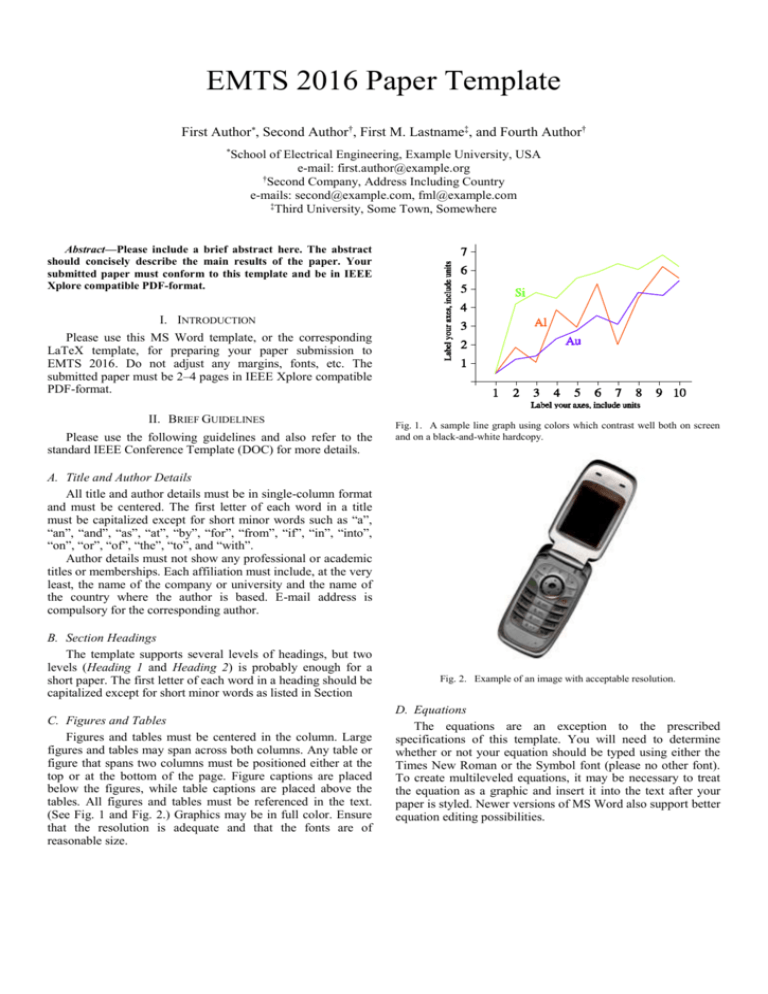
EMTS 2016 Paper Template First Author*, Second Author†, First M. Lastname‡, and Fourth Author† * School of Electrical Engineering, Example University, USA e-mail: first.author@example.org † Second Company, Address Including Country e-mails: second@example.com, fml@example.com ‡ Third University, Some Town, Somewhere Abstract—Please include a brief abstract here. The abstract should concisely describe the main results of the paper. Your submitted paper must conform to this template and be in IEEE Xplore compatible PDF-format. I. INTRODUCTION Please use this MS Word template, or the corresponding LaTeX template, for preparing your paper submission to EMTS 2016. Do not adjust any margins, fonts, etc. The submitted paper must be 2–4 pages in IEEE Xplore compatible PDF-format. II. BRIEF GUIDELINES Please use the following guidelines and also refer to the standard IEEE Conference Template (DOC) for more details. Fig. 1. A sample line graph using colors which contrast well both on screen and on a black-and-white hardcopy. A. Title and Author Details All title and author details must be in single-column format and must be centered. The first letter of each word in a title must be capitalized except for short minor words such as “a”, “an”, “and”, “as”, “at”, “by”, “for”, “from”, “if”, “in”, “into”, “on”, “or”, “of”, “the”, “to”, and “with”. Author details must not show any professional or academic titles or memberships. Each affiliation must include, at the very least, the name of the company or university and the name of the country where the author is based. E-mail address is compulsory for the corresponding author. B. Section Headings The template supports several levels of headings, but two levels (Heading 1 and Heading 2) is probably enough for a short paper. The first letter of each word in a heading should be capitalized except for short minor words as listed in Section C. Figures and Tables Figures and tables must be centered in the column. Large figures and tables may span across both columns. Any table or figure that spans two columns must be positioned either at the top or at the bottom of the page. Figure captions are placed below the figures, while table captions are placed above the tables. All figures and tables must be referenced in the text. (See Fig. 1 and Fig. 2.) Graphics may be in full color. Ensure that the resolution is adequate and that the fonts are of reasonable size. Fig. 2. Example of an image with acceptable resolution. D. Equations The equations are an exception to the prescribed specifications of this template. You will need to determine whether or not your equation should be typed using either the Times New Roman or the Symbol font (please no other font). To create multileveled equations, it may be necessary to treat the equation as a graphic and insert it into the text after your paper is styled. Newer versions of MS Word also support better equation editing possibilities. All displayed equations should be labeled in numerical order. Punctuate equations when they are part of a sentence, as in E = jωμH, ACKNOWLEDGMENT Include acknowledgments here, if needed. Do not use a footnote on the first page. (1) where E is the electric field intensity and… Note that the equation is centered using a center tab stop. Ensure that all nontrivial symbols are properly defined. Use “(1),” not “Eq. (1)” or “equation (1),” except at the beginning of a sentence: “Equation (1) is ...” E. References Number the reference items consecutively in square brackets following the usual IEEE style. When citing a reference, simply use the reference number, as in [1]. Do not add “Ref.” or “Reference” except at the beginning of a sentence, e.g., “Reference [2] shows…” Multiple references can be grouped together like [1], [3]–[5]. Examples of references show below include: a book [1], a journal article [2], a conference paper [3], a web page [4], a patent [5], a master’s thesis [6], a technical report [7], a datasheet [8], and a standard [9]. REFERENCES [1] [2] [3] [4] [5] [6] [7] [8] [9] S. M. Metev and V. P. Veiko, Laser Assisted Microtechnology, 2nd ed., R. M. Osgood, Jr., Ed. Berlin, Germany: Springer-Verlag, 1998. S. Zhang, C. Zhu, J. K. O. Sin, and P. K. T. Mok, “A novel ultrathin elevated channel low-temperature poly-Si TFT,” IEEE Electron Device Lett., vol. 20, pp. 569–571, Nov. 1999. M. Wegmuller, J. P. von der Weid, P. Oberson, and N. Gisin, “High resolution fiber distributed measurements with coherent OFDR,” in Proc. ECOC’00, 2000, paper 11.3.4, p. 109. M. Shell. (2008) IEEEtran webpage on CTAN. [Online]. Available: http://www.ctan.org/tex-archive/macros/latex/contrib/IEEEtran/ R. E. Sorace, V. S. Reinhardt, and S. A. Vaughn, “High-speed digital-toRF converter,” U.S. Patent 5 668 842, Sep. 16, 1997. A. Karnik, “Performance of TCP congestion control with rate feedback: TCP/ABR and rate adaptive TCP/IP,” M. Eng. thesis, Indian Institute of Science, Bangalore, India, Jan. 1999. J. Padhye, V. Firoiu, and D. Towsley, “A stochastic model of TCP Reno congestion avoidance and control,” Univ. of Massachusetts, Amherst, MA, CMPSCI Tech. Rep. 99-02, 1999. “PDCA12-70 data sheet,” Opto Speed SA, Mezzovico, Switzerland. Wireless LAN Medium Access Control (MAC) and Physical Layer (PHY) Specification, IEEE Std. 802.11, 1997.


